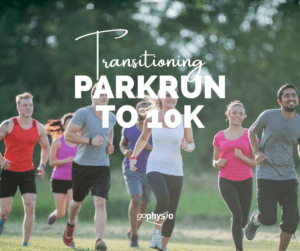
Parkrun started back in 2004 when 13 runners got together on a blustery day in Bushy Park, Teddington, UK. It is now an international family of over half a million runners (and
counting). The Saturday morning 5km is a regular event in many diaries. With so many great 10K’s such as The Eastleigh, goPhysio and Exbury 10k’s and many other longer distance running events round the corner, having nailed a 5k, you may have your sights set on more of a challenge!
So, how do you make the leap from 5k?
When you first started running you probably followed a plan and gradually increased the distance and your body adapted to allow you to run 5km quite happily. Now you want to be able to run even further, this may seem daunting at the beginning. So why not go back to basics and follow the same principle you had when training for 5km.
- Set yourself a goal for when you want to be able to achieve 10km, maybe book yourself onto a 10km race, like the Eastleigh, Exbury or goPhysio 10k, so you have a goal in mind.
- Once you have your goal, follow a training plan that gradually increase your distance each week. There are lots of apps that enable you to enter a date and a distance goal and work backwards and formulate a training plan for you. Just make sure it’s realistic, too much too quickly can overload your body and not give it time to adjust, which is a risk for picking up an injury.
- Why not join a running club or seek help from a running coach for advice, tips, and tricks to help your transition from 5km to 10km.
- Ensure you have varied distance and speed runs within your training. Use hills and interval training too to add different dimensions to your training.
- Listen to your body, if increasing the distance is too hard one week, don’t beat yourself up. Do what you can, the training plan is just a guide.
- Allow your body to recover, have rest days. If we don’t allow ourselves rest days, the body does not have time to repair and recover from your last run.
- Add in some cross training, try clinical pilates to improve your movement control, strength and stability, giving you a great stretch and recovery session. Why not go for a swim for some cardiovascular training without the stresses and pressures on you body. Strength based work is also a really great addition to your training.
- If you start to get a reoccurring niggle or injury get it assessed as soon as possible to prevent it from getting worse. Getting there right advice at an early stage will help prevent needing potentially lengthy treatment or rest from running long term.
- Listen to some music, an audio book or podcast whilst you run or run with friends to keep the training fun.
- Ensure you cool down, stretch, or foam roll. Try using a trigger point MB5 or MB1 ball, which is a great way to release those tight muscles before and after your runs. Some people find a regular deep tissue massage really beneficial too.
Most important of all is to enjoy your training, monitor your progress and don’t panic if you are slightly behind your training schedule remember that is only a guide to help you progress.



